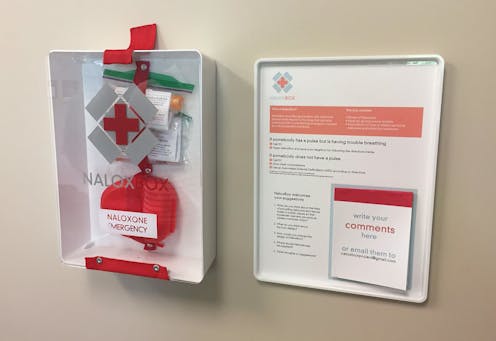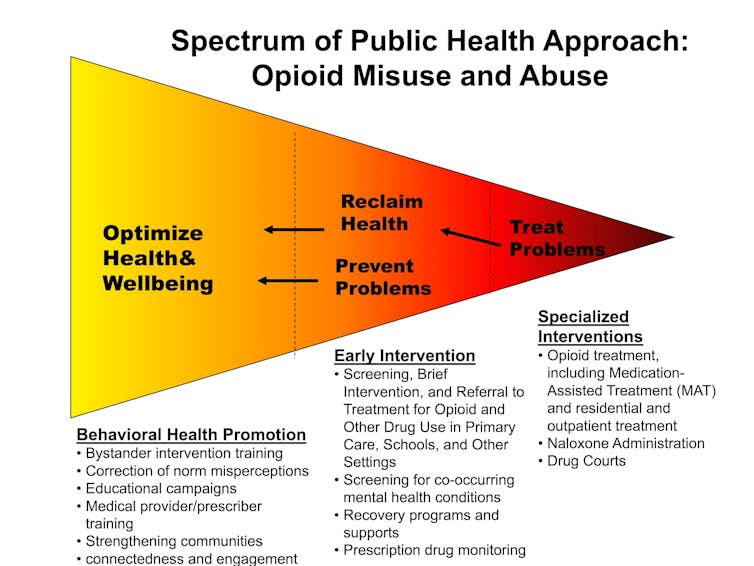To stop the opioid epidemic, the White House should embrace prevention
The White House has laid out a plan to address the opioid crisis. But people suffering from opioid addiction aren't the only ones who need help.

There’s an old adage that states “An ounce of prevention is worth a pound of cure.”
President Donald Trump declared a public health emergency on opioid use on Oct. 24. He outlined several strategies to address the crisis, including plans to establish drug courts in every federal judicial district; to adjust reimbursement rates for addiction treatment; and to streamline federal funding for drug treatment programs.
These plans focus primarily on treating opioid addiction after the problem is detected. In our response to the opioid crisis, the “pound of cure” is prominent. But where can we find the ounce of prevention?
Any comprehensive response to a health issue must consider those who have not developed the problem. When public health and medical professionals responded to the H1N1 crisis several years ago, for example, a great deal of time and resources were devoted to teaching people how to avoid contracting this potentially life-threatening disease.
People are dying from the opioid overdose epidemic, and we must mount an aggressive response in order to save lives. But let’s not forget the needs of those who haven’t developed opioid addiction, or those who are at risk for addiction. Their life trajectories could be changed with the support of timely and responsive prevention efforts.
Why prevention matters
What does prevention entail? At a basic level, prevention means stopping a behavior, like opioid abuse, from ever occurring in the first place. To experts in public health and related professions, it can also entail delaying the onset of that problem behavior or reducing its impact.
Most importantly, prevention also means strengthening individual and community-level health and resilience, as well as promoting policies that improve physical, social and emotional well-being.
Research clearly shows that prevention is effective at enhancing human functioning and reducing psychological and physical distress. Prevention services help to further the health and well-being of both individuals and entire communities across many areas – for example, reducing the negative consequences of alcohol abuse, sexually transmitted infections, diabetes and many other conditions.
There’s clear evidence that expanding preventive services reduces the costs of substance abuse and mental health care. Prevention allows health care workers to address problems early, before costly treatment is necessary.
Prevention policies have been effective in reducing death rates. For example, states that raised the legal drinking age to 21 saw a 16 percent median decline in motor vehicle crashes.
Prevention services can also mitigate the consequences of health issues that may disproportionately affect demographic groups by race, gender, disability, socioeconomic class and other factors.
The importance of prevention is affirmed by the U.S. National Prevention Strategy, a government initiative that aims to shift our nation’s focus from sickness and disease to wellness and prevention.
Preventing opioid abuse
With regard to prevention strategies for opioid abuse and addiction, the federal government has laid out some potentially promising strategies. However, the current opioid emergency response places most of the federal focus – and, likely, available funding – on the needs of a relatively small segment of the population: those with existing opioid use disorders and addiction.
A much larger segment of the population is affected in other ways. Many may have a family member or friend experiencing such addiction. Or they may themselves be at risk of starting to abuse opioids. These people need help to ensure that opioid use problems do not develop in the first place.
There are a few ways that the government can ensure that its current plan addresses the need for prevention.
The White House commission addressing the opioid abuse issue recommended a system for distributing federal funding. This system mirrors the process for obtaining block grants, allocations to states to support substance abuse services. While this recommendation is encouraging, we should ensure that some of these funds are designated to address the needs and build the strengths of individuals and communities who have not yet been affected by the opioid crisis.
The commission also plans to coordinate with private sector and nonprofit groups to implement a national media campaign. This campaign will address addiction stigma and the danger of opioids. As part of this recommendation, it would be important to include messaging indicating that most members of the population do not use opioids, as well as specific steps that communities can take to remain healthy and drug-free.
Finally, the government says it will implement policies that ensure patients are adequately educated about the risks, benefits and alternatives of taking opioids before receiving an opioid prescription for chronic pain. Just as important is the provision promoting the use of nonpharmacological alternatives for pain management by health care professionals.
A comprehensive approach
A comprehensive public health-informed approach to address the opioid crisis may involve responses that affect an entire population, offer early intervention for people who may be at risk for opioid abuse and provide treatment and referral for individuals with already established opioid addiction.

As a psychologist who works in alcohol and drug abuse prevention, I believe that public health professionals need to better understand what makes some individuals gravitate to opioid abuse and addiction. Such findings can help to develop strategies to promote health and resilience.
What’s more, we need to expand federal funding to support research across the spectrum of substance use. Substance abuse in all its forms compromises the health and welfare of millions across our nation. President Trump’s heartfelt comments about his brother, Fred, who died as a result of his addiction to alcohol, underscored this point.
One individual and community at a time, we must focus on supporting the millions of people who haven’t developed opioid addiction. That way, we can stem the tide associated with this devastating public health crisis.
M. Dolores Cimini has received funding from National Institutes of Health, Substance Abuse and Mental Health Services Administration, Office on Violence Against Women, U.S. Department of Justice, U.S. Department of Education, New York State Office of Alcoholism and Substance Abuse Services, and Transforming Youth Recovery.
Read These Next
RFK Jr. wants to scrutinize the vaccine schedule – but its safety record is already decades long
Federal officials are questioning the safety of the vaccine series children receive. Here’s the story…
Deception and lies from the White House to justify a war in Venezuela? We’ve seen this movie before
Two US wars based on lies, in which tens of thousands of American troops and millions of civilians died,…
Miami’s new mayor faces a housing affordability crisis, city charter reform and a shrinking budget
Eileen Higgins won a hard-fought election to become Miami’s new mayor. Now for the hard part – governing…






